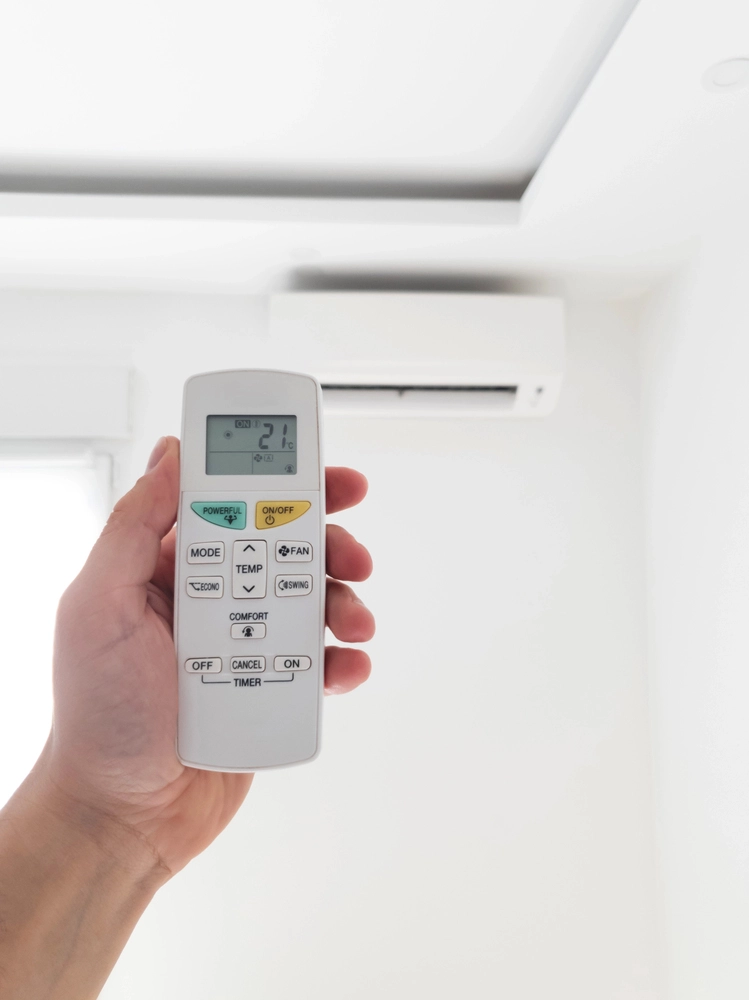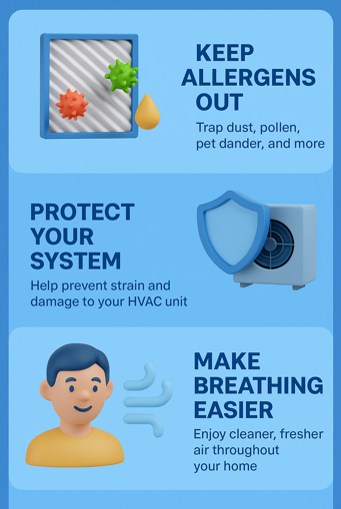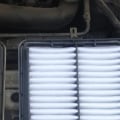If you or your family constantly battle dust, sneezing, or that mysterious musty smell at home, your air filter might be the silent culprit. Upgrading to the right filter size like the 16x18x1 air filters or 20x30x1—can do more than just trap particles. It can shield your HVAC system, reduce allergens, and improve the air you breathe every day. This guide will walk you through how these specific filter sizes help keep your home healthier and your system running smoothly—so you can finally breathe easier.
Top Takeaways
Use the right filter size (16x18x1 or 20x30x1) for proper fit and performance.
Protect your HVAC system by reducing strain and preventing damage.
Breathe cleaner air by trapping dust, pollen, and pet dander.
Lower energy bills with improved airflow and system efficiency.
Replace filters every 1–3 months to maintain air quality and performance.
Why the Right Filter Size Matters for Clean Air and System Protection
There is no denying that when it comes to cleaning the air indoors not every air filter is the same, and sizing is everything. Specialty filters such as 16x18x1 , 20x30x1 are made to accommodate particular HVAC systems by offering the maximum surface area to collect air pollutants which may include dust, pollen, pet dander, mold spores etc.
These filters are applied with high-efficiency media in catching microscopic allergens before spreading in your home. It translates to lesser allergies breakouts, no more dust piles on furniture and a remarkable difference in the freshness of air. More to the point, they assist in the preservation of your HVAC system since debris cannot enter the system and clog coils and motors, which may require expensive repairs or lower efficiency.
All you can do is change your filters frequently, about once every 1-3 months and that will keep you breathing better, not to mention having your heating and cooling system operate smoothly throughout the seasons. If you need to control allergies or just make your environment healthy and clean, the 16x18x1 and 20x30x1 filters are a good choice.

"After years of working with homeowners struggling with poor indoor air quality, I’ve found that simply upgrading to the correct filter size—like a 16x18x1 or 20x30x1—can make a dramatic difference. Not only do these filters trap more allergens, but they also protect the heart of your HVAC system. It’s one of the most cost-effective ways to breathe cleaner air and extend the life of your unit."
Case Study & Real-World Results at a Glance
1. Family Allergy Relief – Atlanta, GA
Problem: Child suffered from year-round allergy symptoms indoors.
Initial Issue: Low-efficiency filter that didn’t fit properly.
Solution: Upgraded to a high-quality 20x30x1 allergen-reducing filter.
Results:
Allergy symptoms eased within 2 weeks.
Less dust throughout the home.
HVAC airflow improved.
Energy use dropped noticeably.
Firsthand Insight: “A simple filter upgrade transformed the home’s air and comfort level.”
2. Property Portfolio Protection – Phoenix, AZ
Problem: Frequent HVAC failures in rental units.
Cause: Inconsistent or incorrect filter sizes.
Action Taken:
Standardized all systems with 16x18x1 air filters.
Set a bi-monthly replacement schedule.
Outcome:
40% drop in HVAC repair requests.
Tenants noticed cleaner, fresher air.
Professional Perspective: “Filter size isn’t a minor detail—it’s your first defense against costly system damage.”
3. Research Supports the Results
The EPA believes that indoor air is usually twice to five times more polluted than the best outdoor air.
Properly sized, high-efficiency filters:
Trap more allergens.
Protect HVAC components.
Improve overall home air quality.
Pro Insight: “I've seen the difference first hand—cleaner air, fewer issues, and better system performance.”
Supporting Statistics: What the Data and Real Experience Reveal
1. Indoor Air Is 2–5x More Polluted
The EPA claims the indoor air is 2 to 5 times more polluted than outside air- in some occasions, it is 100 times worse.
epa.govI’ve seen this firsthand in sealed homes with poor filtration.
Undersized filters often leave contaminants unchecked.
Upgrading to the right filter size immediately reduces dust and improves air freshness.
2. Proper Filter Maintenance Saves Energy
The U.S. Department of Energy says proper HVAC maintenance, including filter replacement, can cut energy use by up to 15%.
energy.govI’ve helped homeowners lower their bills just by switching to a clean, properly fitted filter.
A good filter keeps airflow smooth and reduces system strain.
3. Over 50 Million Americans Have Allergies
The ACAAI reports that 50+ million Americans suffer from allergies each year.
acaai.orgI often meet families unaware that their HVAC filter can help.
Right size + efficient = less symptoms, more sleep and less dirty surface.
Key Takeaway: The evidence-based research and real-world outcomes mean transformation of indoor air quality, energy consumption and the long term health of HVAC systems when using the proper filter size such as 16x18x1 and 20x30x1.
Final Thought & Opinion: Why Filter Size Matters More Than You Think
The Takeaway
An appropriately sized filter; such as 16x18x1 or 20x30x1 does not just block dust.
It purifies the environment, decreases allergies, lowers electric bills, and saves your HVAC system.
What I’ve Seen Firsthand
Families breathe easier
Kids with allergies finally sleep through the night.
Utility bills drop
One simple air filter change = measurable energy savings.
Fewer costly breakdowns
Filters help avoid the destruction of coils and motors by dirt.
My Unique Perspective
Most individuals forget about their filters, until there is an issue.
However, this minor aspect according to what I have witnessed is what matters greatly.
Thermostats or smoke alarms would make our homes healthier, efficient and cleaner in case we treat them like they are.
The bottom line is that a filter is sometimes out of view but never out of mind. Use the appropriate size, rotate it and your house would reward you.
Next Steps: What to Do Now
1. Check Your Current Filter Size
Look for size printed on the frame (e.g., 16x18x1 or 20x30x1).
Confirm it matches your system.
2. Pick the Right Filter Type
For allergies: use MERV 8 or higher.
For pets: choose filters designed to capture dander.
3. Order from a Trusted Source
Choose high-quality filters from a reputable supplier.
Buy in bulk to save and stay stocked.
4. Replace Regularly
Change every 1–3 months.
Replace more often if you have pets, allergies, or high dust.
5. Track the Difference
Watch for cleaner air, less dust, and fewer allergy symptoms.
Improved airflow = better HVAC performance.
✅ Bonus Tip: Set a calendar reminder or subscribe to filter delivery to stay consistent.
Frequently Asked Questions
1. What does the size of an air filter mean, like 16x18x1 or 20x30x1?
These numbers refer to the filter’s dimensions in inches: length × width × thickness. A proper fit ensures full coverage of the air intake and optimal filtration performance.
2. How often should I replace my air filter at home?
For most homes, replace your filter every 1–3 months. If you have pets, allergies, or live in a dusty area, monthly replacement is recommended.
3. Can using the wrong air filter size damage my HVAC system?
Yes. A poor fit can cause air leaks, reduce efficiency, and lead to dust buildup and system strain, potentially shortening the lifespan of your HVAC unit.
4. Do air filters help with allergies?
Absolutely. High-efficiency filters sized correctly for your system can capture pollen, dust, pet dander, and mold spores, reducing allergy triggers in the home.
5. What is the best air filter for home use?
The best filter is one that fits your system (e.g., 16x18x1 or 20x30x1) and has a MERV rating of 8–13 for optimal allergen and dust filtration without overloading your system.
Learn more about HVAC Care from one of our HVAC solutions branches…
Filterbuy HVAC Solutions - Miami FL - Air Conditioning Service
1300 S Miami Ave Apt 4806 Miami FL 33130
(305) 306-5027



